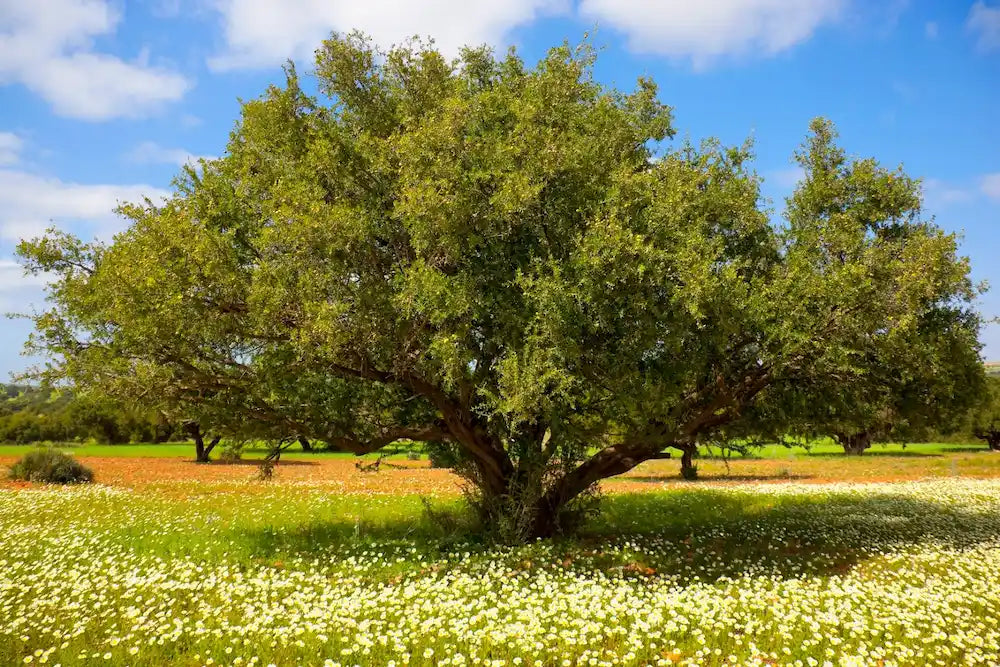
How is Cosmetic Moroccan Argan Oil Made?
Moroccan Argan Oil, often referred to as "liquid gold", is a precious and highly sought-after ingredient in the cosmetic industry. Known for its rich moisturizing, anti-aging, and healing properties, this luxurious oil is extracted from the kernels of the argan tree (Argania spinosa), which grows exclusively in the semi-desert region of southwestern Morocco. The traditional process of making cosmetic argan oil is both intricate and labor-intensive, involving a blend of ancient practices and modern techniques to ensure the highest quality oil is produced. Here's an overview of how cosmetic Moroccan argan oil is made.
1. Harvesting the Argan Fruit
The process begins with the harvest of the argan fruit, which occurs between May and August. These small, round fruits resemble olives and contain a hard nut at the center, which houses the kernels used to make argan oil. The fruit is typically collected once it has fallen from the tree, indicating ripeness.
In rural areas, Berber women often gather the fruit by hand, carefully picking each one from the ground. Some traditional practices involve letting goats climb argan trees to eat the fruit, and then collecting the nuts from their droppings. However, for cosmetic purposes, it's more common nowadays to bypass this step to maintain hygiene and ensure a purer product.
2. Drying and Cracking the Nuts
Once harvested, the argan fruit is left to dry in the sun for several weeks. Once completely dry, the outer flesh is removed to reveal the argan nut inside. This nut is incredibly tough, and cracking it open is a laborious task traditionally done by hand using stones. It requires precision and skill to avoid damaging the precious kernels within.
In many cooperatives across Morocco, Berber women continue to use this hand-cracking method, which has been passed down through generations. In some larger-scale operations, machinery is now employed to crack the nuts, but many believe that the traditional method yields a higher quality oil.

3. Extracting the Kernels
After cracking the argan nuts, the kernels, which are almond-like seeds, are extracted. These kernels are the key component in producing argan oil. For cosmetic oil, the kernels are used raw, unlike the edible version where the kernels are roasted to enhance flavor.
4. Grinding and Pressing
The next step is grinding and pressing the kernels to extract the oil. Traditionally, this was done using a stone hand mill, but today, cold-pressing machines are commonly used in modern production to ensure the oil retains its valuable nutrients and fatty acids. Cold-pressing involves applying pressure to the kernels without the use of heat, which helps maintain the integrity of the oil.
This pressing process results in a thick, golden liquid. For cosmetic purposes, only the first press of the oil is used, as it contains the highest concentration of beneficial properties, including essential fatty acids, vitamin E, and antioxidants.

5. Filtration and Refinement
After the oil is extracted, it undergoes a filtration process to remove any impurities or solid particles from the pressing. In traditional methods, the oil is left to settle for a few days, allowing the solids to sink to the bottom, and the clear oil is then skimmed off the top. In more modern setups, mechanical filtration systems are used to speed up the process while ensuring the purity of the final product.
For cosmetic-grade argan oil, minimal refinement is performed to ensure that the oil maintains its natural golden color and nutty aroma. Some cosmetic companies may further refine the oil to reduce its scent, but this can sometimes strip the oil of some of its beneficial properties.
6. Bottling and Packaging
Once the oil is filtered and refined, it is bottled and packaged for distribution. High-quality argan oil is typically stored in glass bottles to protect all its nutrients, plastic bottles can degrade the oil over time. The packaging process ensures that the oil retains its freshness and potency until it reaches the consumer.
Sustainability and Women's Cooperatives
The production of Moroccan Argan Oil is not just about creating a luxury beauty product; it's also deeply tied to the local culture and economy. Many argan oil producers operate within women’s cooperatives, where Berber women are employed to handle the traditional aspects of the oil-making process. These cooperatives provide a vital source of income for rural Moroccan communities and help to preserve the ancient techniques of argan oil extraction.
In addition to supporting local economies, the production of argan oil plays a role in environmental sustainability. Argan trees are protected under UNESCO, and the cultivation of these trees helps to prevent desertification in the region. Many argan oil producers are also committed to sustainable farming and fair trade practices, ensuring that the oil is produced ethically and responsibly.
PeauFresh Moroccan Argan Oil is not only a beauty staple, but it also represents a tradition rooted in Moroccan culture and sustainability. From the careful harvesting of the fruit to the intricate process of extracting and refining the oil, every step is designed to preserve the rich properties of this "liquid gold." Whether used in hair care, skincare, or anti-aging products, argan oil's journey from the argan tree to your cosmetics shelf is a testament to the craftsmanship and dedication behind its production.
Latest Blogs
Discover Tips, Trends, and Insights for Radiant, Healthy Skin.



